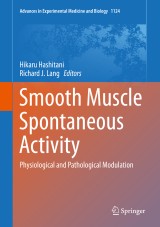Details

Smooth Muscle Spontaneous Activity
Physiological and Pathological ModulationAdvances in Experimental Medicine and Biology, Band 1124
|
171,19 € |
|
| Verlag: | Springer |
| Format: | |
| Veröffentl.: | 10.06.2019 |
| ISBN/EAN: | 9789811358951 |
| Sprache: | englisch |
Dieses eBook enthält ein Wasserzeichen.
Beschreibungen
<p>This book presents the commonality and heterogeneity of the mechanisms underlying smooth muscle spontaneous activity in various smooth muscle organs and in addition discusses their malfunctions in disease and their potential as novel therapeutic targets. To facilitate understanding, the volume is divided into five parts and covers 16 organs: airways, gastrointestinal tract (phasic muscle, tonic muscle), renal pelvis, ureter, urinary bladder, urethra, corporal tissue, prostate, uterus, oviducts, seminal vesicle, artery, vein, microvasculature, and lymphatic vessels. This structure will help readers to comprehend the most up-to-date information on the similarities and differences in the contractile mechanisms driving various smooth muscles as well as their potential manipulations in particular visceral organ pathologies. The vast advancements in gene, electrical recording, and imaging technologies in this field are also discussed, with review of past achievements and consideration oflikely future developments. This book will be of worldwide interest to clinicians, students, and researchers alike. </p>
<div><p>PART I: Gastrointestinal tract.- Phasic muscle.- Spontaneous electrical activity and rhythmicity in gastrointestinal smooth muscles.- Tonic muscle (Sphincters) .- Generation of tone by gastrointestinal sphincters.- PART II: Urinary tract.- Renal pelvis.- Pacemaker mechanisms driving pyeloureteric peristalsis: modulatory role of interstitial cells.- Ureter.- Excitation-contraction coupling in ureteric smooth muscle: mechanisms driving ureteric peristalsis.- Urinary Bladder.- Spontaneous activity and the urinary bladder.- Urethra.- Spontaneous activity in urethral smooth muscle.- PART III: Reproductive organs.- Corporal tissue.- Ion channels and intracellular calcium signalling in corpus cavernosum.- Prostate.- Generation and regulation of spontaneous contractions in the prostate gland.- Seminal vesicle.- Mucosa-dependent, stretch-sensitive spontaneous activity in seminal vesicle.- Uterus.- The myometrium – from excitation to contractions and labour.- Oviducts.- Myosalpinx contractions are essential for egg transport along the oviduct and are disrupted in reproductive tract diseases.- PART IV: Blood vessels.- Artery.- Cellular and Ionic Mechanisms of Arterial Vasomotion.- Vein.- Venous Vasomotion.- Microvasculature.- Role of pericytes in the initiation and propagation of spontaneous activity in the microvasculature.- Lymphatic vessels.- Lymphatic vessel pumping.- PART V: Airways.- Regulation of airway smooth muscle contraction in health and disease.<br></p></div>
<div>Hikaru Hashitani has been Professor of Cell Physiology at Nagoya City University since 2010. He received his medical degree from Kyushu University, completed his PhD at Nagoya City University, and then studied at Melbourne University and University of Oxford. His research interests have primarily focused on cellular mechanisms underlying spontaneous electrical and calcium signalling in smooth muscle of the genitourinary, gastrointestinal and microvascular systems.</div><div><br></div><div>Richard Lang received his PhD at Monash University in 1979. He was an MRC Research Officer and Fellow at St George’s Hospital Medical School, London. He returned to Monash University as a Research Fellow and has continued as a Senior Research Fellow. Throughout, he has been interested in the role membrane ion channels and calcium play in pacemaker and tone generation in both gastrointestinal and urogenital organs.</div><div><br></div><div>Hikaru Hashitani and Richard Lang have collaborated for over 20 years, exchanging a number of graduate students for short term visits and one PhD graduate on a JSPS Fellowship. Over this time, we have together published 20 papers and numerous conference abstracts on the electrical and calcium signalling properties of the renal pelvis, urethra and prostate. This collaboration is a continuation of a long-held tradition of international collaboration between British, Japanese and Australian smooth muscle researchers that originated by our mentors in Oxford University in the 1960s.</div>
This book presents the commonality and heterogeneity of the mechanisms underlying smooth muscle spontaneous activity in various smooth muscle organs and in addition discusses their malfunctions in disease and their potential as novel therapeutic targets. To facilitate understanding, the volume is divided into five parts and covers 16 organs: airways, phasic muscle, tonic muscle, renal pelvis, ureter, urinary bladder, urethra, corporal tissue, prostate, uterus, oviducts, seminal vesicle, artery, vein, microvasculature, and lymphatic vessels. This structure will help readers to comprehend the most up-to-date information on the similarities and differences in the contractile mechanisms driving various smooth muscles as well as their potential manipulations in particular visceral organ pathologies. The vast advancements in gene, electrical recording, and imaging technologies in this field are also discussed, with review of past achievements and consideration of likely future developments.This book will be of worldwide interest to clinicians, students, and researchers alike.
Detailed, up-to-date information on smooth muscle function Systematically organized by body systems and organs Explanation of commonalities and differences between organs Clarification of the role of smooth muscle in disease Exploration of contractile mechanisms as therapeutic targets
<p>Detailed, up-to-date information on smooth muscle function</p><p>Systematically organized by body systems and organs</p><p>Explanation of commonalities and differences between organs<br></p><p>Clarification of the role of smooth muscle in disease<br></p><p>Exploration of contractile mechanisms as therapeutic targets<br></p><div><br></div>
Diese Produkte könnten Sie auch interessieren:

The Neural Crest and Neural Crest Cells in Vertebrate Development and Evolution

von: Brian K. Hall

149,79 €















